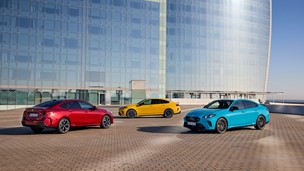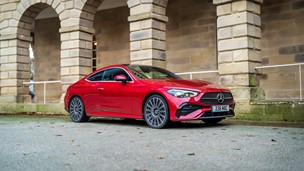Ford has applied the RS badge with varying degrees of care to a selection of models over the past 39 years. There can be no doubt that it was applied honourably to the original Escort RS1600 of 1970, the epoch-making Sierra RS Cosworths and the competition-only RS200 mid-engined sports car, but I dare suggest that you would have to be intensely fanatical about the 1981 Escort RS1600i and the 130bhp Fiesta RS1800 of 1992 to consider them in the same league.There can't be any argument about the badge's use here, though. The most powerful Focus yet devised is the 22nd RS, the first in seven years (after the strictly limited-edition previous Focus RS), the second in - amazingly - fifteen years and, if you go by standard outputs while ignoring figures achieved in cars developed for motorsport use, the most powerful at 301bhp.That figure is developed by a thoroughly reworked version of the 2.5-litre turbo engine originally created by Volvo and used in the Focus ST as well as the Mondeo, S-MAX and Galaxy. In its new form it is remarkably flexible, quite capable of accelerating the RS from 30mph in sixth gear (starting at just over 1000rpm) and of giving the car reasonable performance even if you don't rev it beyond 3000. And although its absolute peak is at nearly maximum revs, you can still call on something very close to the full 301bhp anywhere between 4500rpm and the 7000rpm cutoff.It's a fine unit, and under heavy load it sounds great (though the five-cylinder howl and the wastegate chatter during gearchanges make me think Audi rather than Ford every time I hear them). But the big issue about the RS is not so much the engine itself as the fact that all its power is aimed at the road through the front wheels.This is something that will probably be debated by Ford enthusiasts several decades from now: the official line is that Team RS could have developed a 4x4 if it wanted but that, in the words of Chief Engineer Dirk Densing, "front-wheel drive was our preference all along".Other spokesmen have made similar comments, though I can't help feeling that the lady doth protest too much and that budget restrictions were of more significance than anyone is admitting. But it doesn't matter now. The RS is a 301bhp front-wheel drive car and that's that.Making a car of this power and layout acceptable to drive is not easy, but it can be done: Cadillac, for example, made a magnificent job of it more than a decade ago with the Seville STS, which I still say handled absolutely brilliantly even though its road behaviour was described in the media as "inexcusable". I don't know who wrote that, and I certainly didn't sit beside them in a Seville, but I suspect that their ability to time inputs of steering and throttle accurately was some way short of excusable itself.The same applies to the old Focus RS, whose Quaife limited slip differential was largely blamed - unfairly, I think - for supplying dollops of torque steer when in fact it behaved perfectly respectably at high speeds as long as you didn't try to bury the accelerator into the bulkhead when the car wasn't ready for it.The new RS also has a Quaife LSD (in somewhat revised form), but in contradiction to the old arguments the chances of encountering torque steer have been limited by the introduction of the patented RevoKnuckle, whose invention is simply a result of Ford paying more attention to the suspension geometry than it did when developing the previous RS.Although RevoKnuckle is clever, I think its main achievement is to keep the Focus well-mannered even when a clumsy oaf is driving it. Clumsy oafs will certainly drive the car (I dare say a few have already) but stamping on the throttle pedal whenever you feel like it is not the way to get the best out of the RS, particularly because it's front-wheel drive.This remains a very important point: the RS absolutely does not feel like its 4x4 rivals, principally the Subaru Impreza WRX and Mitsubishi Evo X. It is very obviously front-led, and can have its potential limited much more easily than is the case with the Japanese cars. If you do stupid things with it, it will do stupid things back, even if the quality of the set-up means that those things are not as frightening as they might otherwise have been.But I think the more important point is that the Focus RS is a wonderful machine when you're working hard but well on a really challenging road. It leaps between corners, wipes off unrequired speed brilliantly (the balance between braking strength and straightline performance is quite beautiful), settles down amazingly quickly once you've turned in and swoops through the rest of the corner so serenely that you do briefly wonder if four-wheel drive would have made much difference.It even tackles bumps and crests well, though inevitably you'll experience a loss of grip (if you've switched off the ESP) or power (if you've kept it on) sooner than in a similarly powerful 4x4.I drove the RS over the very same road which made me fall in love with the Cadillac Seville STS in the 1990s. It is an incredibly challenging piece of tarmac, and I can't immediately recall any other car which went over it anything like as quickly. But I do remember several which set the sweat glands on my palms to Max and in some cases persuaded me to call a halt to the festivities miles before I reached the next town. The RS didn't even come close to doing that.Perhaps the best thing about the car is that it combines all I've described already with exceptionally good road manners at lower speeds. Around town it feels almost indistinguishable from the much less potent ST, and if it happens to have been painted blue it will attract about as much notice from your fellow road users.(Attention-seekers may like to note that a colleague who drove a white example virtually brought every town he drove through to a standstill, and heaven knows what effect you would generate if you went for the £725 Ultimate Green option.)Just a few housekeeping details to sort out before we finish. The price of the RS is, as noted below, £25,740, but you can bump that up by going for a few extras such as Bluetooth connectivity for £200 and part-leather trim for £500. The most expensive option is the Luxury Pack 2, which consists of air-conditioning, automatic headlights and wipers, a self-dimming rear view mirror, rear parking sensors, tyre deflation detection, a key-free system and a touchscreen DVD navigation system. That lot costs £1500, but you can save £750 by going for Luxury Pack 1, which is the same but without the navigation. Engine 2522 cc, 5 cylinders Power 305 bhp @6000 rpm Torque 325 ib/ft @2250 rpm Transmission 6 speed manual Fuel/CO2 30.1 mpg / 225 g/km Acceleration 0-62mph: 5.9sec Top speed 163 mph Price From £27846.00 approx Release date 01/04/2009

Our Rating



